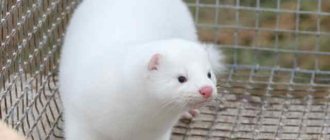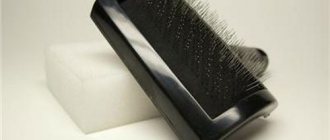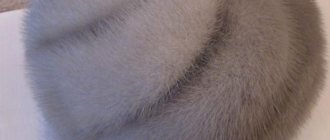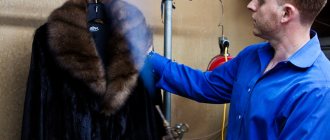A fur coat is a luxurious product made from natural fur, which is distinguished by its practicality, elegance and attractive appearance. An expensive item reflects the status of its owner and emphasizes her dignity.
A fur coat is considered the most prestigious and sophisticated element of a wardrobe, which requires special care and respect. To ensure that furs do not lose their appearance and please the eye for as long as possible, you need to remember the basic rules of storage and care.
Storing mink coats in winter
In order to extend the life of a mink coat, it must be taken out into fresh air more often. But lately the weather has somehow not been kind to Russians with cold winters, so it will take quite a long time to choose the right time to wear a fur coat.
The ideal period for walking a furry beauty would be dry, frosty and not too sunny weather. However, one may not expect such mercy from nature.
Vegetation in the closet will negatively affect the beauty of the product, so you will have to go out in a fur coat at the wrong time. But after such a walk, some problems may arise, for example, with drying.
How long does fur last?
Wear resistance of fur
determines the service life of the product.
The most durable fur is otter fur
.
A fur coat made from this fur
will last about 20 seasons, from a river beaver - 18, from a fur seal - 15 - 17 seasons. The service life of mink products is 10 years, fur coats made from marten, astrakhan fur and blue fox are 7, nutria and fox are 5.
Interesting materials:
How to water Ficus Benjamin? How to water ficus benjamina in summer? How to water Ficus Rubber in winter? How to water phlox? How to water fuchsias? How to water geraniums to make them bloom? How to water geraniums in summer? How to water hyacinth at home? How to water indoor hibiscus? How to water hippeastrum at home?
Drying a mink coat
Proper drying is slow drying.
It is forbidden:
- Place the fur product above any heat sources, including radiators; heaters, fireplaces;
- Use a hair dryer;
- Comb wet fur.
In all these cases, the skin of the fur coat will quickly lose its elasticity, and the hairs will begin to fall out.
It will be much more effective:
- Shake the fur coat;
- Walk through the damp fur with a special brush (you can buy it in fur salons) or blot the hairs with a clean cloth;
- Hang the fur coat on hangers and leave to dry naturally.
Special conditions are a whim for an artificial one, but a severe necessity for a mink coat.
You can keep your fur coat in perfect condition only if certain conditions are met.
When buying an expensive coat or fur coat, you want to be irresistible and do not allow the thought that such clothing may become unusable. To prevent this from happening, it is necessary to create special storage conditions. Under the influence of various factors, such as increased air temperature, humidity or poor ventilation, natural fur can fade, turn yellow, lose wear resistance and become brittle . Hair may fall out, forming bald spots on clothing.
But this, as a rule, does not apply to artificial material. A fur coat made of synthetic fibers is not afraid of sunlight, changes in temperature and humidity, and is also not of interest to moths.
Storing mink coats in a closet
Professionals advise placing fur products in a separate closet, and the temperature inside should not exceed 5 degrees, but few lovely female representatives can afford such a luxury. Therefore, most often, the mink is put away in a common closet.
But don't stuff your fur coat into the narrow space between your winter coat and your running jacket. Space for a mink is no less important than cold.
To ensure the best conditions, the cabinet should be:
- Spacious (from the fur coat to the nearest item or door there should be at least 10 centimeters);
- Dark;
- Standing away from heat sources.
Periodically (every 10-15 days), the fur must be taken out of the closet and shown to the outside world. If you can’t walk down the street wearing furs, then leave the fur coat on the balcony for a day, protecting it from the sun’s rays.
What can happen if you don't follow the rules?
A fur coat is a fairly expensive wardrobe item that requires careful storage. Let's look at the most popular fur storage mistakes and possible methods for eliminating them.
Moth damage
It’s not difficult to hang a moth sachet in your closet, but if you forget about this easy care measure, the result will be almost irreparable: a moth-ridden fur coat loses all its charm.
Careless storage can result in damage to your fur coat.
You cannot store household chemicals in the closet at the same time as your fur coat. If the cleaning agent gets on the fur, it will no longer be possible to restore it.
Creases on a folded product
If you store a fur coat folded, it will inevitably become wrinkled. If the bruises are not severe, then to bring it into proper condition, you will need a hanger, a fur brush or a foam sponge. You can try to straighten your fur coat in two ways:
- The first one is to use steam. First, turn on the hot water in the bathroom. When steam forms, place the fur coat on a hanger. It should remain in the bathroom until it is completely smoothed out. After this, shake the product well and dry in a ventilated area.
Do not keep your fur coat in the steam for longer than necessary, otherwise it will become deformed.
- If the fur coat is slightly wrinkled, you can resort to the second method. Wet the sponge and carefully go over the problem areas in the direction of the pile. Then comb the fur and dry the coat. If necessary, repeat the alignment.
Drying of the flesh
When storing the product in conditions of low humidity or high temperature, drying out of the core may occur . The flesh is the processed skin on which the fur is located.
With an increased level of humidity, the inner layer, on the contrary, stretches.
You can try to soften dried, hard pulp with a solution of 1 liter of water, 1 tbsp. l. vinegar and 50 g of salt. Apply this mixture to the inside of the skin for 2 hours. Then mash the flesh and rinse with water.
A mixture of soap solution is also suitable for this purpose, to which you should add ¼ of its volume of fat and 1/10 of glycerin. Treat the flesh with this mixture and leave it for 5 hours. Then rinse and rub the skin with chalk to remove any remaining oil.
If the membrane is overstretched, normalize the humidity levels in the room.
Yellowness on white fur and fading of dark fur coats
When exposed to sunlight, the fur loses its color. Dark fur coats may fade, and light fur coats may turn yellow. In the first case, proceed like this:
- soak a cotton pad in a 9% vinegar solution and treat problem areas;
- take a napkin, apply alcohol to it and wipe the fur until it is dry;
- Comb the product and hang it to dry.
If the fur coat is made of tsigeika or astrakhan fur, your actions should be the opposite. It should be dried first and only then combed.
As a result of violation of storage rules, yellowness appears on light fur. In addition to the influence of ultraviolet rays, this is caused by the ingress of dust, soot, perfumes and cosmetics.
Don't spray perfume on your fur. It absorbs aromas well, but over time the smell will change and become unpleasant.
Dry cleaning will help get rid of such marks. But only if the damage is minor and formed recently. If the yellowness is significant, exposure to chemicals will further aggravate the situation. In this case, you can take a risk and resort to home methods.
Sorbents have bleaching properties. For example, semolina, bran or starch. Processing options:
- Lay out the fur coat, apply sorbent (semolina, wheat or rye bran must first be heated in a dry frying pan for a few seconds) and rub it into the fur. Then shake the product and comb.
This is the most gentle bleaching method, so it may leave yellow areas. In addition, if semolina is poorly combed, it will attract moths.
- The second method is more effective. Dilute 3% hydrogen peroxide or ammonia in equal proportions with water in a 1:2 ratio, moisten a cloth and wipe the yellowed areas. There is no need to rinse off the solution.
- If the previous two methods did not help eliminate the problem, you can use whitening shampoos for animal hair. For example, All Sistem Whiteninq, HERBAL WHITENING SHAMPOO. However, the fur coat cannot be washed. Dilute a few drops in water and treat the fur with a sponge.
If after all the above methods the fur has not acquired its original color, it needs to be dyed. But under no circumstances should dyeing be done at home. Take the fur coat to a studio that provides this service .
All white fur coats, regardless of the origin of the fur, are stored in blue cases. This helps avoid yellowing.
Storing mink coats in summer
But, of course, a big problem is storing fur coats in the spring-summer-autumn period. The ideal option would be to place it in a special refrigerator, but such a service cannot be found in every city, and not every owner of an expensive outfit will want to part with it, even for the summer.
For such housewives, there are several simple rules that allow you to preserve the original beauty and functionality of the product.
How to store a white or blue mink fur coat
This is not to say that a white mink coat is impractical. No more than a fur coat of any other color. But it certainly needs more careful handling. The dirt on it is more visible, and often it is better not to dry-clean your fur coat - this is bad for the fur. Although the yellowing process on a white fur coat will be more noticeable than on a blue mink.
Yellowing of fur occurs most quickly in bright light, both natural and artificial. That’s why it’s also so important to store it correctly: in a closet, in a special case. Depending on the color and quality of the fur, the yellowing process will occur unnoticed for about 4-5 seasons.
It should be stored in a colorless case that allows air to pass through well, and before hiding it in a closet, the mink fur should be carefully wiped with a clean cloth soaked in lemon juice, which should be diluted with water.
Inspection of fur coats before storage
Before storing a fur coat, it must be carefully inspected.
To do this, shake the doha and look for:
- Scuffs;
- Fur loss;
- Dried dirt (collar, sleeves, hem become problem areas);
- Lining defects;
- Valuables left in pockets.
The last point is not mandatory and serves, rather, to reassure the hostess.
It is better to fix other problems in specialized salons, although you can hem the lining yourself.
Cleaning and drying
In addition to the unkempt appearance of an expensive item, dirt on a fur coat very often means a satisfied moth. Therefore, it is better to remove dirt immediately after it appears. But if this was not possible, and then the stain was simply forgotten, then a special brush will come to the rescue.
Dry cleaning will remove complex dirt. It’s better to forget about the existence of a washing machine once and for all.
- After the fur coat has acquired its original beauty, it can be put away for storage.
- However, only perfectly dried products can be stored.
- So if in doubt, shake the fur coat thoroughly, ensuring that all hairs are completely straightened, hang it on a hanger and place it in a dry place away from heating.
If the fur has become matted during wear or storage, you will have to carefully comb your outerwear. But pulling, tearing or cutting the fibers is strictly prohibited. Unlike a cat, a fur coat will not acquire new lint.
Preventing moths
The cover, unfortunately, does not protect the fur from moths. Therefore, it is advisable to treat the material with a special spray or aerosol . Insecticides in the form of sprays are widely available on sale. On the packaging of such a product there are instructions for use, which indicate the frequency of processing. For example, Mosquitall, Tornado or Raptor. This impregnation must be renewed every 3 months, as it loses its properties.
Advice!
Do not spray your fur coat, otherwise marks will remain on it; apply the product exclusively to the cover.
Don't forget to put moth repellent in the closet or spray the cover of your fur coat.
You can put pieces of cedar bark in your pockets: moths do not tolerate this aroma, and, accordingly, will not encroach on the fur coat. In addition, its smell does not disappear. Dry geranium, lavender or citrus peels are also suitable for this purpose. But folk remedies are inferior in effectiveness to aerosols and sprays. Do not use naphthalene. It repels moths well, but is a carcinogen, which is why many countries have banned its use for several years.
But home remedies for combating voracious insects are inferior in terms of effectiveness to high-quality aerosols.
If the moth has finally reached the fur coat, it will be noticeable immediately. The pile will lie sloppily and bald spots will form in it. When shaking the item, pieces of wool that the moth has managed to damage will separate from it. And the larvae of this pest will be present in the folds.
If the presence of moths in a fur coat has become obvious, you should not hesitate, you need to act urgently.
The first step is to use a powerful insecticide. If everything is done in accordance with the instructions of the drug, within the next hour or two you can deal with the moth and prevent the insects from completely destroying the coat.
If moths are present, the fur is treated with an aerosol, put in a cover and left there for several days. If the cover does not close completely, the item is placed in a tight polyethylene bag and treated with the drug every day so that its effect does not weaken.
Preparing to store mink coats
Before placing a fur coat for summer imprisonment, you should:
- Fasten all buttons, hooks, zippers;
- Remove from belts, brooches, hairpins and other jewelry;
- Place on wide hangers to help avoid deformation and sagging.
It is better to store the belt on the same hanger, throwing it over the crossbar; It is not recommended to tuck the sash into pockets or sleeves.
For additional safety, the fur coat can be placed in a fabric bag or carefully packed in a clean cloth.
The use of vacuum covers, plastic bags, trunks and suitcases is prohibited. The same goes for folding a fur coat in half or in thirds. The product should only be stored in an upright position.
Additional recommendations
In order for a fur coat to serve for a long time and be pleasing to the eye, you must follow the general recommendations:
- The product must not be dried with electrical appliances or in the sun.
- You should not carry bags and backpacks on your shoulders - marks and scuffs will remain.
- If the product is exposed to snow or rain, it should be dried at room temperature on a hanger. It is forbidden to leave a fur coat near the fireplace or over the radiator!
- to pin various accessories to the product : such decorations spoil the appearance of the fur.
- Do not spray oils, perfumes, or other odorous products on the product.
A fur coat is an expensive pleasure that requires a reverent attitude on the part of the owner. In order for the product to maintain its appearance and shape, it must be properly cared for. By creating favorable storage conditions, every woman will protect this luxurious piece of clothing from external factors and parasites - as a result, the fur coat will serve the owner for a long time.
You can learn more about proper storage of fur coats by watching the video :
Storing mink coats in a closet
Summer storage is no different from winter storage: it must be dry, dark, and spacious.
An additional condition for happy survival until the new season will be the absence of moths.
- It’s better not to even remember about naphthalene; it became a thing of the past back in the 20th century.
- Special tablets or plates will destroy unwanted guests much more effectively.
- Sachets made from lemon, orange, tangerine, and grapefruit peels remain a good folk method of fighting insects.
- Moreover, household members will be happy to provide material for updating them.
Moth sprays get along very poorly with fur. Not only will the fur coat smell of insecticides, but chemical components can worsen the structure of the fur. Only the walls of the storage facility can be treated with such preparations.
First fur
Once upon a time there lived a clever merchant Mikhailov in Moscow. More than anything else, he loved money and hunting, and therefore quickly rose to the rank of the first supplier of fur for the court of His Imperial Majesty. An intelligent man, Mikhailov quickly realized that it was better to immediately import large quantities of skins to Moscow from Siberia, rather than having to travel for them every time the emperor’s family needed a new fur coat.
The merchant Mikhailov built the first fur refrigerator in Russia next to his trading house on Bolshaya Dmitrovka
Knowing that furs love the cold, in 1912 the merchant built near the Kuznetsky Bridge - the then sanctuary of luxury and fashion - an eight-story house with huge refrigeration machines capable of constantly maintaining a low temperature in the building. To protect the furs, there are no windows from the third to eighth floors, and therefore no harmful sunlight. The air is cooled using artesian water, and the interior walls of a dozen refrigeration chambers are lined with exotic Indian cork. The skins and finished products are delivered to the ground floor by two lifting machines.
The first fur refrigerator contained fur coats and hats of Nicholas II and his entourage, stoles of famous metropolitan ladies, coats of wealthy citizens and flirtatious boas of Olenka Gribova, the owner of a fashionable salon, for whose heart many Moscow gentlemen fought.
Advertising is the engine of trade and the promoter of services. This was known at the beginning of the 20th century 30_2
The skins lay in Mikhailov’s establishment for years, and their quality was the envy of many foreign guests. Today it is the oldest refrigerator in the world, which is still registered at the old address: Bolshaya Dmitrovka, 11.
Airing a fur coat
But even in the most spacious closet a fur coat will be boring, so in the summer you need to take care of a walk. A loggia will help with this, where the fur coat is hung about once every couple of months, protecting it from bright sunlight. In this case, the fur coat can be combed additionally.
Simple rules will help you keep your fur coat safe and save yourself from unnecessary worries about the quality of an item of clothing that is expensive in all respects.
Choosing a case
Fur should be stored in colored cases made of natural fabric.
Under no circumstances should a fur coat made from natural fur be stored without a cover. Otherwise, the product will fade, become wrinkled and lose its luxurious appearance forever. The cover must be fabric. Vacuum bags for storing fur products are contraindicated. The fact is that, firstly, the fur coat will have to be folded, since it is almost impossible to find a cover of a suitable size. And secondly, condensation forms in a closed bag, which negatively affects the villi and inner parts - treated leather, the basis for fur. So, what are the requirements for a fabric cover?
- It should be breathable and made of natural fabric (linen, cotton, canvas).
- The width of the bag should be slightly larger than the width of the fur coat.
- The length should be 10–15 cm longer than the fur product.
- The insert on the cover should be located on the side - this is the only way the fur coat will not be squeezed, and it will be much more convenient to pack it.
- It is better if the cover has a transparent “window” - when storing several fur items in one closet, it will be more convenient for you to figure out which is which.
- The sun's rays should not fall on this transparent insert, since ultraviolet radiation negatively affects fur even through polyethylene.
- The color of the cover should repel sunlight, so rich blue, dark brown, and black are preferred (to prevent the paint from transferring to the fur coat, when purchasing a packaging bag, run a damp cloth along the inside - if there are no marks left, you can buy).
- Before placing the fur coat in the cover, treat it with anti-moth spray, and then repeat the treatment every 3 months.











